PRE2019 4 Group8
Group Members
| Name | Student ID | |
|---|---|---|
| Sietse Backx | 1255924 | s.backx@student.tue.nl |
| Rien Boonstoppel | 0946480 | d.j.boonstoppel@student.tue.nl |
| Luc Geurts | 1237117 | l.p.a.geurts@student.tue.nl |
| Mandy Grooters | 1236053 | m.grooters1@student.tue.nl |
| Tar van Kieken | 1244433 | t.m.k.v.krieken@student.tue.nl |
Introduction
Visiting a theme park or a festival can be a great stress relief. However, what is worse than to start a relaxing event with trying to park your car in what seems to be a never-ending, saturated parking lot. Event parking is a key issue in society nowadays. With occasional large social gatherings, parking demand often does not meet supply. In combination with a shortage in parking staff, congestion results leaving drivers with frustration.
When organizing a large scale event, there are several key aspects to take into account with regard to transportation and vehicle placement or traffic management in general. The first key bottleneck to consider is the road capacity [1]. Accessibility to event sites is often limited due to the fact that the location was not designed for large events. Next to that, cost is an important factor when planning an event. In most cases, it would not be sensible to construct a parking lot for a single event. Finally, the time scale of an event is important. Can visitors arrive over the course of several days or mere hours? In order to create an effective event transportation plan, the traffic bottlenecks need to be dealt with. The first measure to optimize the transportation, is to create travel capacity. This can either be done by reducing transport system demand or by increasing capacity. For instance, if the event is planned during a holiday, more transportation facilities such as buses are available to be used for the special event. A second approach is to inform visitors that transportation and parking will take considerable time. Essentially, by conveying a warning, visitors might decide to arrive earlier which spreads demand peaks. Another improvement is to take traffic efficiency measures. For example, by using traffic signals to favor the event traffic flow, delays can be reduced. Additionally, travel bans can be implemented to open capacity for event traffic. Finally, the emphasis should be on public transportation to prevent parking issues in the first place [2]. If all these measures still lead to congestion, a new solution must be found.
Analogously with large events, in large cities, parking is also a considerable problem. Nearly 30% of traffic congestion in cities is caused by drivers looking for a parking spot [3]. Designing a parking system such that drivers can find a parking faster is therefore essential. Common solutions involve a LED system to indicate free and occupied parking spaces, however, these solutions do not control traffic flow. Another option which does take into account traffic flow is automatic parking spot assignment. Automatic parking assignment can compute optimal routes taking into account lot occupancy, travel distance, conflict avoidance and walking distance [4]. Nonetheless, this solution is limited to mobile phone use.
Stukje over airports, omdat dat ons voorbeeld word
Objectives
Subject
A robotic parking assistant which helps drivers to find a parking spot and simultaneously optimizes traffic flow for faster parking.
Problem Statement
In summary, the key issues to resolve are the enormous rise in demand of parking spaces with special events and the inadequate parking management. These issues result in congestion and frustration of drivers due to the delay suffered from finding a parking space. This project researches the possibility to improve the parking experience on parking lots. Focus is on parking lots with a proper road surface, and a limited number of entrances/exit. These constraints exclude temporary parking lots on meadows, or general parking spots along a road. In addition to the research, we design a partial solution for the issue by making a physical design of the parts of the system that the user would interface with, and software to manage the parking lot plus a simple simulation.
RPC's
In order to investigate possible solutions, requirements, preferences and constraints have to be established.
Requirements
- The system should be able to know in which path and row in the parking lot it is located at any moment in time.
- The system should be able to operate autonomously.
- The system should regulate traffic flow for both entrance and exit of the parking lot, taking into account the total capacity of the parking lot.
- The system should detect if cars are parked on the wrong parking spot or more than 20 cm over the parking lines and take this into account in the determination of free parking spots.
- The system should not come closer than 0.7 meters to the secondary users [5] [6]
- The system should be able to detect when the secondary user needs a parking spot for disabled or older people.
- The system should be able to communicate with the secondary users in a clear way where they need to go for their designated parking spot (97% of the people should understand the communication).
- The system should have a help option to solve parking issues and if needed contact the primary user to help the secondary users
- The system should handle cars up to 5 meters in length and up to 1.8 meters in width. [7] [8]
- The system should be waterproof.
Preferences
- The system should be able to handle payments at the exit.
- The system should look as humanly as possible to decrease the distance where the secondary user feels an invasion of personal space.
- The system should be able to read the licence plate of the cars.
- The system should be able to guide the user to its car when they forgot their parking space, based on the license plate.
- The system should be able to investigate the parking layout by itself.
- The system should give users the opportunity to state their parking preferences and handle those accordingly.
- The system should be able to instruct the driver to park their vehicle properly if it is misplaced.
- The system should have a feedback option.
- The system should have an emergency option.
- The system should be able to fill a parking lot with cars in a shorter time than current valet-parking options.
- The system should be able to measure the length, width and height of the incoming car, in order to know whether it fits in certain parking spaces.
- The system should be cheaper to exploit than current valet-parking options over a span of 10 years.
Constraints
- The system should be ground-based.
- The parking lot has clear entrance(s) and exit(s) which can be regulated and entrance.
- A parking space has the following dimensions in the Netherlands. [9]
- 5 meter length by 2.4 meter width, when perpendicular parking.
- 6 meter length by 2.5 meter width, when parallel parking.
- 6 meter length by 3.5 meter width for the disabled parking space when parallel parking.
- 5 meter length by 3.5 meter width for the disabled parking space when perpendicular parking.
Deliverables
The goal of the project is to deliver a design for the parking robot. This design is dependent on the needs of the users, the requirements we made earlier and the working space, which is in this case a parking lot on an airport, like Schiphol. Furthermore do we want to develop a software, which recognizes parking spaces and gives the best parking space dependent on the preferences to the user. We will also finish this wiki page in such a way that it shows the complete progress that we made during this project. Lastly will we make a presentation video, which shows the steps that we made in this project.
User, Society and Enterprise
Users of the Parking Robot
The primary users of the parking robot are companies that are dealing with large parking lots. Such as theme parks and festival organizations. These companies want to improve the experience of their visitors by avoiding parking problems. The parking robot will significantly decrease the waiting times for a parking spot and thus increase the overall experience of the visitors.
The secondary users are the visitors of theme parks and festivals that are directly interacting with the parking robot to find a parking spot. The parking robot can quickly guide them to a parking spot. Without the parking robot, visitors would have to wait longer which adds stress and frustration to their day which will decrease their experience [10]. These secondary users can be divided into different categories which are again assigned to their designated parking areas. The primary users can assign these specific areas to their preferences and it depends on their targeted audience. As an example, one can have a different parking area for disabled people, an area for the elderly and an area for large families. These groups all have different preferences with respect to where they want to park. To elaborate on this, the elderly for example, they want to have parking spaces closer to their destination which will provide them with a shorter walking distance. Disabled people will also want their designated parking spots close to their final destination and extra room for parking as they sometimes are dependent on wheelchairs or other devices. They may also need quick access to wheelchair ramps, restrooms and special ticketing services. As for the family category, they don’t need any special preferences as they can just be used to fill up the remaining parking spots when all the others have been assigned.
For society, the parking robot can have great improvement opportunities. The parking robot will be more efficient than the current traffic controllers, which will improve the traffic flow around the parking lots. Consequently, the traffic flow on high- and motorways around the parking spot will improve. Therefore, people that do not visit the theme park or event will not experience any delay in their travel due to this effect. Furthermore, congestion increases fuel consumption, environmental pollution and traffic accidents. [11] So the parking robot will have a decreasing effect on these matters too.
From an enterprise perspective, multiple groups can take advantage of the parking robot. First, the organization of events and theme parks. They don’t have to deploy traffic controllers anymore. Which eventually could decrease their overall costs. Secondly, the research that will be done is interesting for the development of other robots. The navigation and communication technique used in the parking robot could be applied in other areas as well. When the parking robot will be developed on a larger scale, robot companies have to produce more robots than they do now, which will eventually decrease the cost per robot. The profit companies make, because of the enhanced traffic flow caused by the parking robot, could be used to do more research on parking robots or robots who use this navigation and communication technology in general. Such can lead to the continuous improvement of the used techniques.
When summarized, we can identify the following user groups:
- Deployer companies: The companies deploying the system
- Drivers: The people that need to park their car
- Disabled people: People that need to find a parking spot suitable for people with physical disabilities
- Infirm people: People that have walking difficulties
- Bad drivers: People that have more difficulty with driving and parking
- Average people: People that don't have special needs of any type
Human Robot Interaction
Touchscreens
Because of the current state of the world around the coronavirus we choose not to use touchscreens. Although it is not yet scientifically proven that this virus is spreading over surfaces, it is widely proven that touchscreens are a possible contamination hazard. [12] So below is elaborated on three other possible solutions for the interaction with the proposed system.
Speech based
This is the most promising solution in my opinion. The voice is the most prominent and the primary method of communication among the human beings. With speech humans can also communicate with robotic systems. However, the possibility that the proposed system is going to be used in busy and noisy environments is quite high. So there need to be some sort of enhancement over a simple microphone. In 1990 already the research on the use of microphone arrays in order to enhance speech recognition based on beamforming. [13] In recent days, Google has made huge improvements with their Cocktail Party challenge. With only a single audio track but with added video feed, they were able to completely isolate voices. [14] So possibly by combining those both solutions will lead to a great performance on speech recognition in busy and noisy environments.
Gestures based
The second possible way for interaction with our robotic system is gesture based. Some research is done on the use of gestures for the interaction. [15] For example by using cameras or a Kinect to view gestures of the secondary users. However, this can be difficult because of the restricted space a driver has behind the wheel. Maybe using hand signals something is possible.
Touchless display
A different, more experimental approach is more like a classic touchscreen. However, without touching the actual screen. A touchless display is developed which can sense local variations of the humidity in the air.[16] When you point a finger, local air humidity changes, which can be translated tot spatial information using those ultrasensitive humidity sensors. The simplicity of the interaction via a touchscreen-like display is already widely acknowledged, so that is a advantage. But it is a very experimental display so its reliability has yet to be proven.
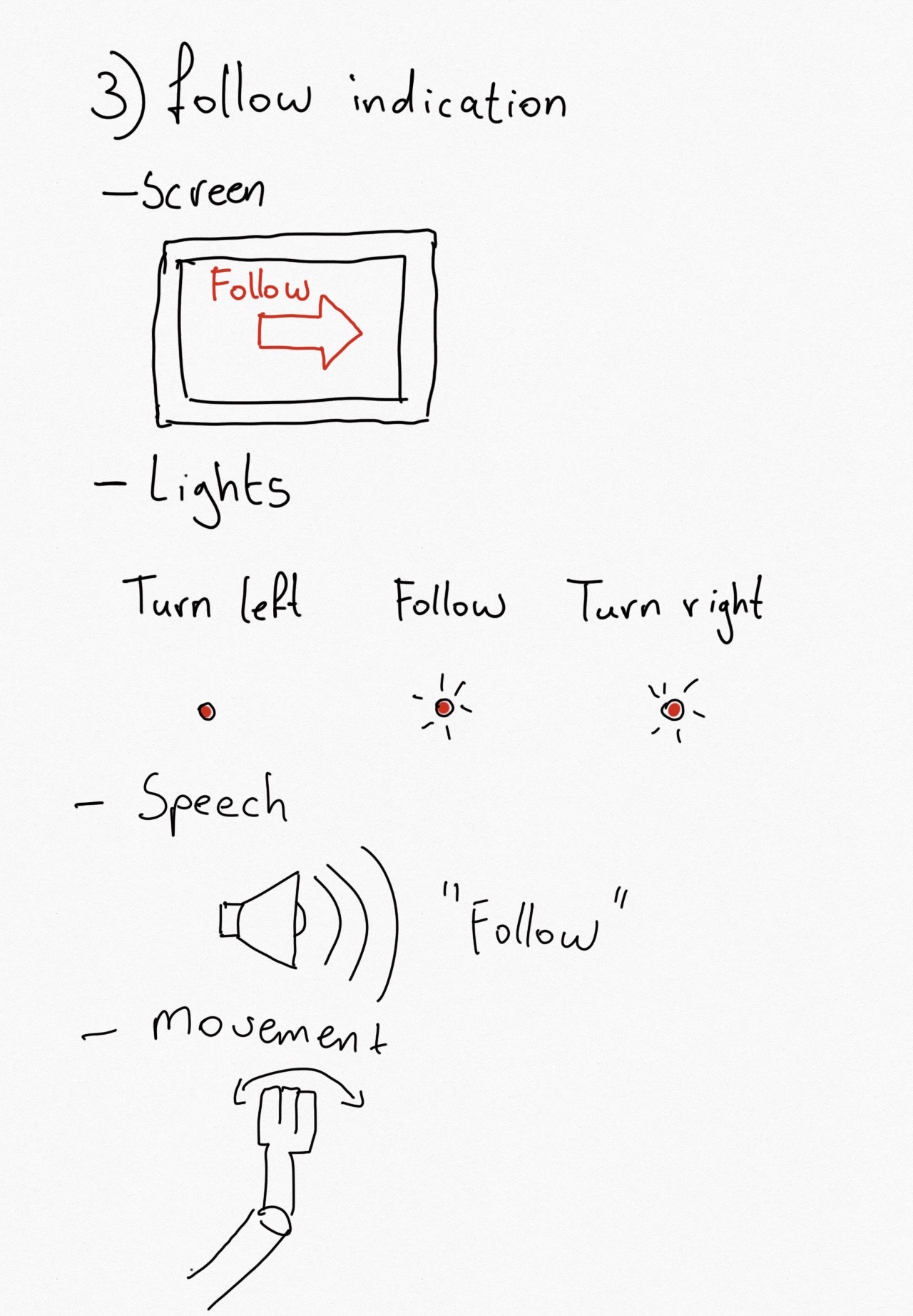
Software
State-of-the-art
A lot of technologies are produced for the tracking of the availability of parking spaces. The simplest and first technology for tracking the availability, is the tracking of the total capacity of the parking lot and the amount of cars which enter and leave the space. This is already used in a lot parking spaces of malls, theme parks or other parking lots with a clear enter and leave point.[17]
The second method is to check if there is a vehicle on a parking spot with a detection unit on every parking unit itself. This detection unit can for example be an induction coil, ultrasonic sensor, infrared sensor, pressure sensor or a microwave sensor. The information of all detection devices is then gathered in one management system, to check the overall availability of the parking lot. The individual spots can be characterized by giving a value of 1 or 0 in the system or by setting them as “AVAILABLE” or “OCCUPIED” on the place where it is shown to the user.[18] [19]
Another method for the tracking of free parking spaces, is to use a given three-dimensional model of the parking lot. A capture device can then be used to represent an image of the parking lot, which can be compared with the three-dimensional model of an empty parking lot. From this comparison of the two three-dimensional models, the availability of parking spots can be determined and translated back to the user.[20]
The parking lot can also be divided in different slots of a certain number of parking spaces. For example, ten parking spaces can be divided into two slots of five parking spaces. The GPS of cars can be used to track in which parking slot the car is located. From this information can be determined how many parking spaces are left in each parking slot and can the next car be directed to the parking slot with available parking spaces. [21]
All the previous systems use some kind of tracking method to determine the availability of the parking spaces. Another method is predicting the availability of parking spaces by looking at patterns in old data. With this method is giving a precise number of available parking spaces not possible, due to the accuracy of long term predictions, the other parking lots in the area and the user behavior. However, if the accuracy of this method is high enough, can it still result in good approximations of the vacant places on parking lots. [22] [23]
Architecture
We wrote software which can be used as 'the brain' of the parking lot. This software is able to run on a local server at a parking lot, and all robots are able to communicate with it over an internet connection. This software is written in TypeScript[24] and runs in NodeJS[25]. It uses Socket.io[26] in order to facilitate symmetric communication. In addition, a front-end web application is provided through the server, in order to show a simple simulation of the parking lot. This was added to show the capabilities of the system, without having to create the physical robots. This application is also written in TypeScript[24] and uses the following important libraries:
- React[27] for view creation
- Model-React[28] for data management
- PixiJS[29] for dynamic graphics
- React-Pixi-Fiber [30] to use PixiJS with React
- Fluent UI[31] for UI components
Algorithms
The main goal of the software is to track what parking spaces are available, and to find appropriate parking spaces for users. To achieve this, the owner of the parking lot has to provide a graph that represents the parking lot. All valid vehicle paths, but also pedestrian paths will have to be present in this graph. Special nodes also have to be marked, which includes:
- Parking spots
- Vehicle entrances
- Vehicle exits
- Pedestrian entrances
- Pedestrian exits
Each of the nodes also contains spatial data for where it's located in the parking lot.
Below is an example graph, where colored nodes have the following meaning:
- Light green: Vehicle entrance
- Dark green: Pedestrian entrance/exit
- Light red: Vehicle exit
- Purple: Parking spots
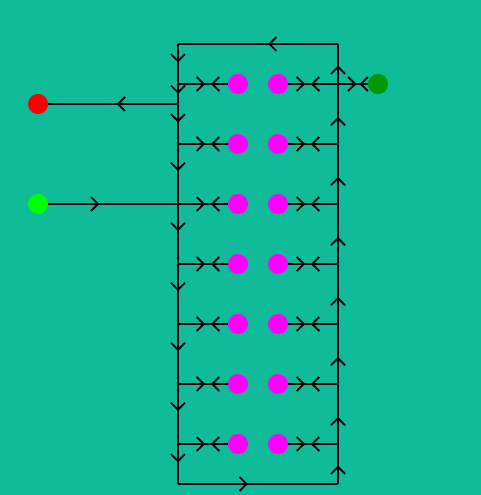
Search algorithm
Dijkstra's algorithm[32] together with a min-heap[33] is used to perform the search. This algorithm can find the cheapest path between two nodes in a graph, in an efficient manner. It computes the cheapest path from a start node to any node in the graph. This by itself is not sufficient for our search however, since we aren't just interested in the distance between two points. We want to consider a number of variables, including:
- Total driving distance from entrance to exit
- Total walking distance from parking spot to an pedestrian exit
- Total walking distance from a pedestrian entrance to the parking spot (in case there are seperate entrances and exits)
- Difficulty to get to a parking spot (based on E.G. number of turns required)
In order to consider all these aspects, graph transformations are used to obtain graphs that Dijkstra's algorithm[32] can be used on.
Graph transformations
Given the graph of the parking lot, the software will create so called 'search graphs'. These are graphs where the physical location of nodes is abstracted away. These do not represent the parking lot in a physical manor anymore, but all relevant information to determine the ideal spot is retained. This relevant information is encoded in the form of edge weights, which can be used to determine costs from one node to another. This way the cost to get from the entrance to a parking spot can still be determined, without having to consider physical location. Each node also contains a reference to the node it was created from, in order to translate path found in the search graph back to a physical route. The system creates 3 different search graphs, which are all used in the final search that combines the information:
- Pedestrian entrance to spot graph
- Pedestrian exit to spot graph
- Vehicle entrance through spot to exit graph
These graphs are only created once when the system starts up, therefor efficiency of creating these isn't a major concern.
Pedestrian entrance to spot graph
This graph is a simple graph that uses Euclidean distance as weights on all edges, and only retains nodes and edges that may be traversed by pedestrians. This graph therefor allows the distance between a given entrance and any parking spot to be determined
Pedestrian exit to spot graph
Similar to the other pedestrian graph, this graph uses Euclidean distance as weights on all edges, and only retains nodes and edges that may be traversed by pedestrians. In addition, it reverses all edges, such that if you were only allowed to walk towards the exit over a path, you are now only allowed to walk away from the exit over said path. This graph therefor allows the distance between a given exit and any parking spot to be determined
Vehicle entrance through spot to exit graph
This graph only retains edges traversable by vehicles. It first creates two instances of the graph, where the first doesn't contain any vehicle exits, and the second doesn't contain any vehicle entrances. Then it connects the two graph through the parking spots. An example illustration is provided below.

This way we can search for the cheapest path from a vehicle entrance to a vehicle exit, which has to pass through at least one parking spot. In this graph, all edge weights are simply the euclidian distance between the nodes.
A second transformation is applied to this graph, which introduces costs for each turn taken. Every node in the original graph is replaced by the product of the set of incoming and exiting edges. This way we can add an edge between any pair of incoming and exiting edges, and give it a weight relative to the turn that's required to make this transition. An example illustration is provided below.
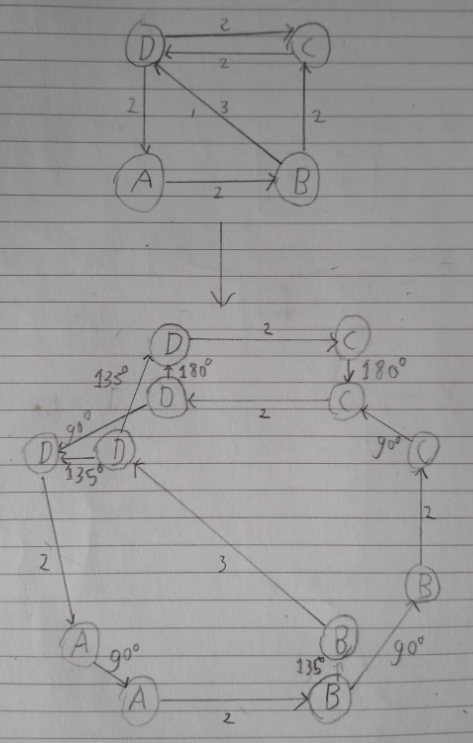
Using this graph we can find the spot that requires the minimal distance to be driven, and fewest turns to be taken.
Graph search
In the search algorithm, the information of all 3 graphs is combined. First a search is executed on both pedestrian graphs in order to determine the cost to reach any spot by foot. In this search a 'walk cost' is used to multiply the distances with in order to consider user preferences.
Then a search is done in the vehicle graph. In this search any turn edge is multiplied with a 'turn cost' to once again consider user preferences. When the search algorithm encounters an edge through a parking spot, the walking cost calculated in the previous spot is provided. In addition an infinite cost is provided in case the parking spot is already taken. The result of this search will is the cheapest path from the entrance to the exit of the parking lot, passing through a parking spot. The parking spot is extracted from this path in order to retrieve the pedestrian paths to and from this spot as well, and all paths are returned as the search result.
The costly graph transformations are only executed once, and per search we only have to use Dijkstra's simple and efficient search algorithm a couple of times.
Results
The simulation can be viewed at herokuapp. The software is running on a centralized server. Thus any changes made, such as parking a car, are visible to anyone visiting the site. The source-code of the software will be visible in the future
Hardware
State-of-the-art
If the information of the available parking places is measured, it is important that the system can choose the best possible parking spot for the vehicle. There are different performance measures for the best parking spot, but the most used ones are a combination of that the time riding to the parking spot and the time walking from the parking spot to the destination are minimal.[34]
When the optimal parking spot is chosen, can this be passed to the user in different ways. The first one is to show the route to the parking spot on the dashboard of the vehicle. A lot of cars nowadays have GPS on the dashboard and this can be used to show the information of the parking spots. This results in that there needs to be a continuous information flow between the vehicle and the availability of the parking space.[35] [36]
This can however also be done with predicted information of the availability of the parking spaces. This information can be given to the GPS of the vehicle, such that the route to the predicted available spot is displayed on the dashboard.
A lot of the times, employers are deployed to guide the vehicles to the empty parking spots. This can be seen on parking lots for places like festival, amusement parks and museums. This can be replaced by robotic solutions. Signs can be set on the ground with information on where the vehicle needs to go for the empty parking spot. For example a sign with an arrow or an cross can be used to show in a simple way for the user, which way he needs to follow. [37]
The employers can also be replaced by robotic vehicles that lead the vehicle to the best parking spot. These robots can fully ride the way of the beginning of the parking lot to the parking spot, or can be used as robotic employers, by going to the crossings and then showing the right way to the user in the vehicle.
Concepts
Obstacle avoidance and parking availability
In order for the system to avoid parked cars and guide drivers safely to their designated parking spot, the system should be able to observe its environment and determine its position. To be able to this, two types of sensors can be used, namely: dead reckoning sensors and environmental sensors. Dead reckoning sensor operate by integrating sensor data over time to determine the vehicles position. Environmental sensors are used to gather information about the vehicles surroundings. [38]
The first sensor option is to use cameras which can observe in 360° short or long range. These cameras can be placed either on top of the vehicle, on the sides of the vehicles or externally placed (see figure below). The key application for this cameras is to recognize objects. Some tasks such as traffic light identification is only possible with the use of cameras. However, because of the great amount of pixels, camera data processing can be intensive. On top of that, camera quality is susceptible to environmental conditions such as rain, fog or snow.
Radar can also be used either at short or long range. Different objects reflect the radio waves differently. The advantage of using radar is that positional and velocity data can be acquired simultaneously. On top of that, radars are impervious to weather conditions. Despite, radar acquired data yields low resolution and a 2D image.
Lidar uses light to receive information about distances between objects. Lidar is used for short range applications. It is used to obtain position and geometry of an object. [39] If multiple Emitter and receiver sets are placed on the vehicle, Lidar can be used to create a 3D image of the environment. Next to that, because dark and light objects reflect light at a different intensity, Lidar can be used to detect road markings. A disadvantage is that Lidar data can be affected by the weather.
Ultrasonic sensors are short range and unaffected by weather conditions. Currently, ultrasonic sensors are used for parking assist.
GPS can be used to determine the vehicle position globally. GPS, however, is not enough to determine the position with great accuracy, as GPS can only obtain an objects position with 1-2 m accuracy.
In general, all of the sensors considered above have pros and cons. Hence, these sensors are often used in combination in self-driving vehicles. [40]
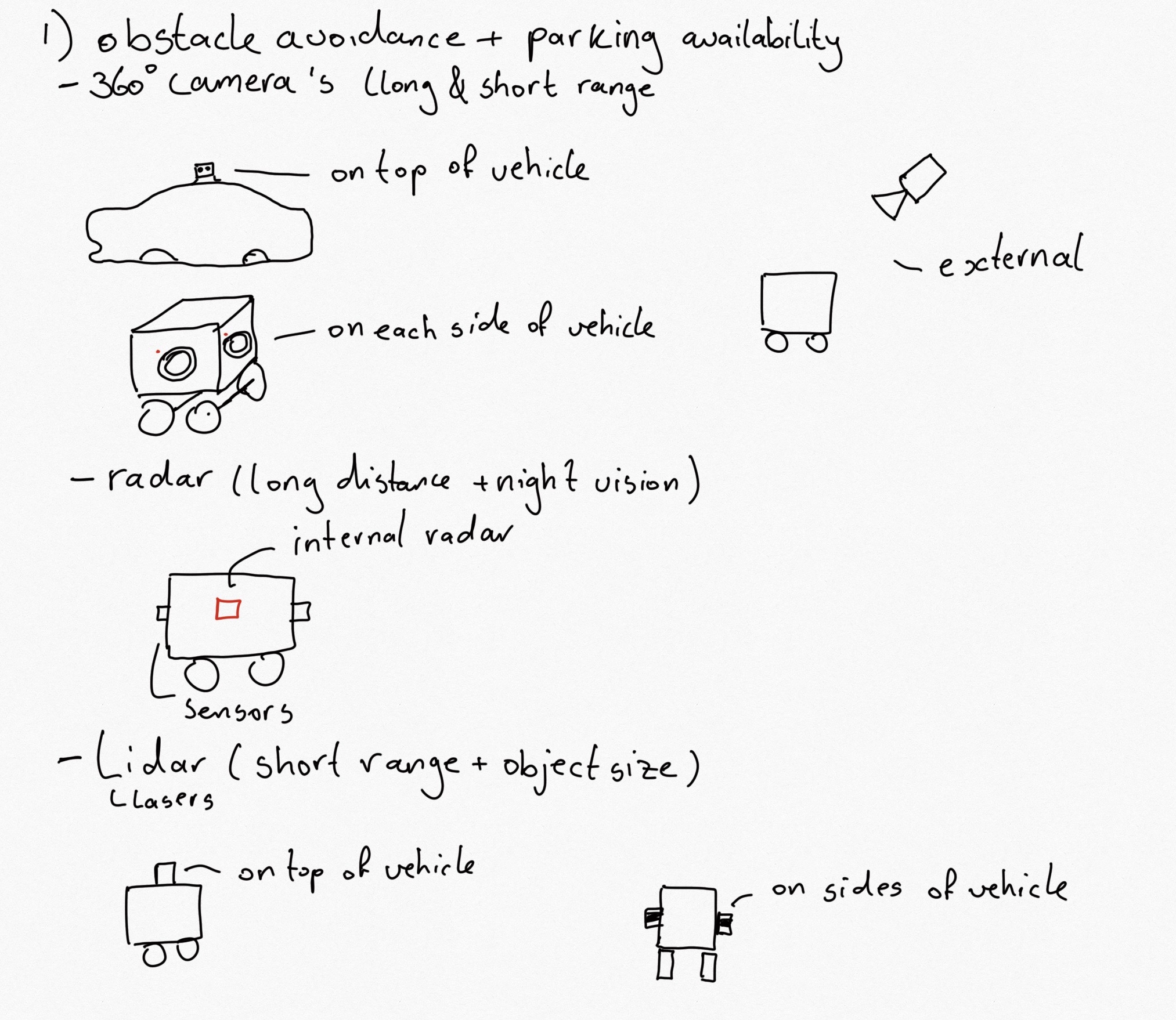
Vehicle motion
Another crucial aspect of the parking assistant robot is motion. The robot should both be able to operate on asphalt and rough terrain. Therefore, a solution must be found to allow smooth operation in both environments.
The first option is to use large wheels with a thick profile. If the wheels are independently propelled and sprung, the vehicle will even be able to have grip in a muddy and bumpy environment. Another option is to use tracks. Tracks are used in the most inaccessible terrains. However, tracks are not as suitable for use on asphalt. Another option is to use legs. The advantage of legs as that they can move the vehicle in nearly all environments. Nonetheless, legs often require complex mechanical actuating systems (see figure below).
Additionally, steering must be considered. This can either be done by rotating left and right wheels or tracks at different speeds or by turning the front or back wheels.

Integrated solutions
Requirement: able to turn on its place Preference: as small footprint as possible
Solution 1
A two wheel based self-stabilizing robot – like a segway
- Display on eye level
- Sensors on top
- Weight distribution on top en bottom in order to maintain balance
Pros
- Small wheelbase, able to navigate to relative small places
- Agile
- Ability to keep itself upright after perturbation
Cons
- Possibly less stable
- Possibly dangerous movements when trying to keep itself upright
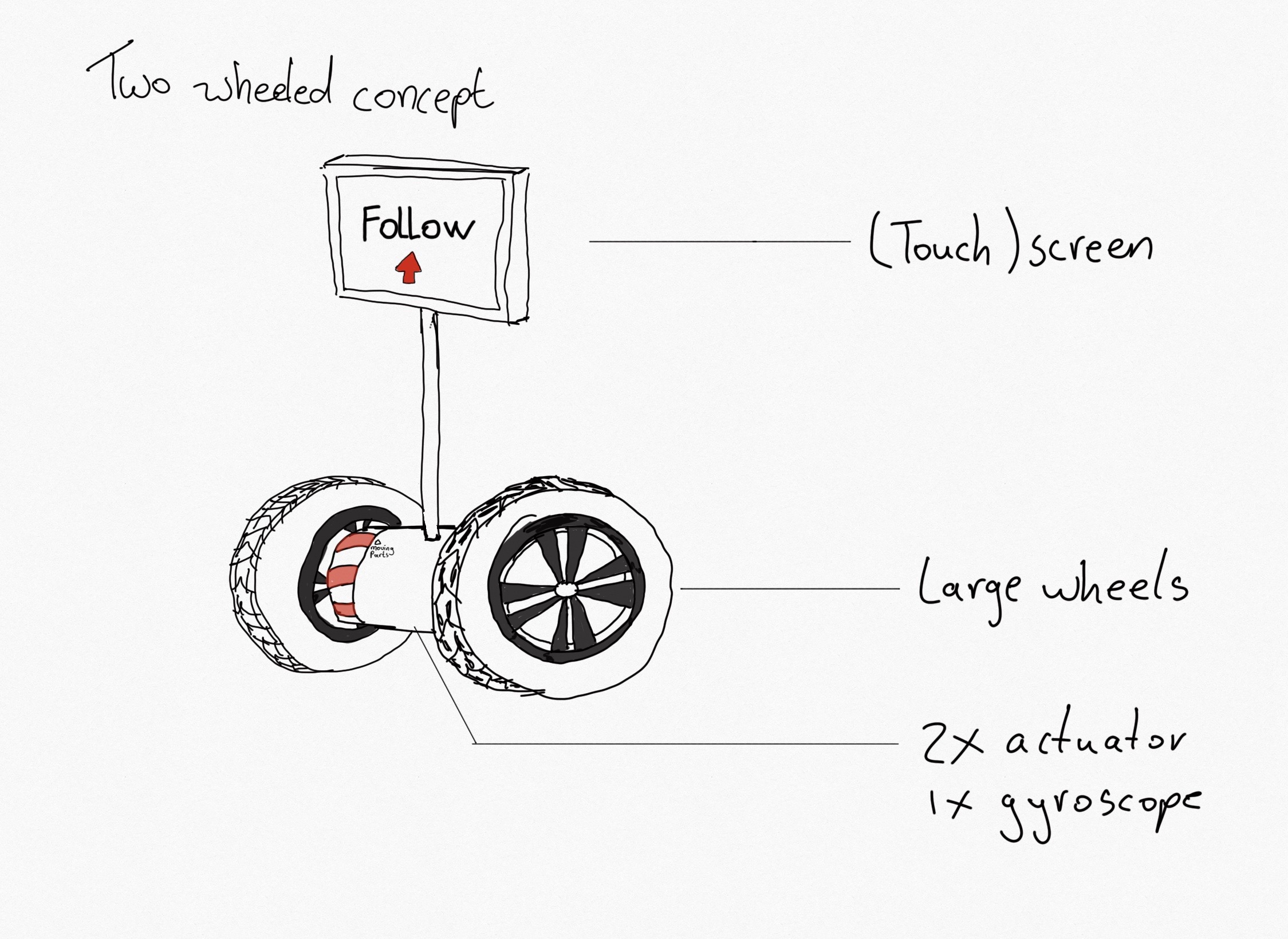
Solution 2
A four wheel based robot – two powered wheels, two caster wheels
- Display on eye level
- Sensors on top
- Weight distribution on bottom in order to lower center of mass
Pros
- Stable from itself
Cons
- Less ability to react to perturbations to keep itself upright
- Because of the dimensions of the robot (way taller then wide) not that stable
- Bigger footprint then two wheel based
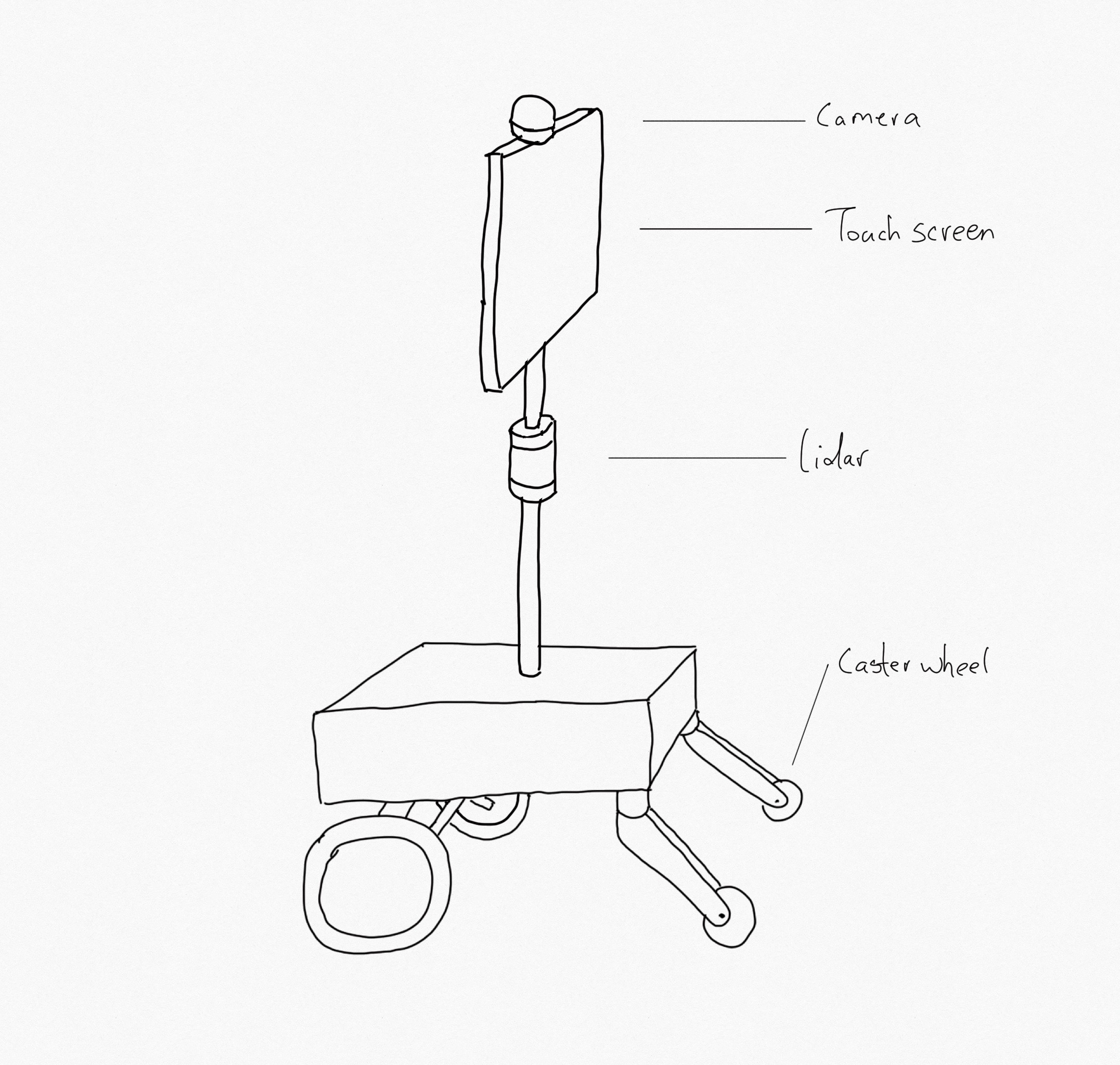
Solution 3
A two wheel based robot, with added extra control wheel. The arm of this of this extra control wheel is sprung and shock absorbing, the wheel can be a fixed one or a castor wheel and is in normal use not touching the ground.
Pros
- Same as solution 1
Cons
- More stable then solution 1
- Because of the added control wheel smaller correction suffice to keep upright, so it is less dangerous

Solution 4
With the previous two wheel based solutions, stability is a key issue. Also, with a narrow base four wheel base robot, tipping over is a risk. Therefore, this concept has four wheels with a larger width and length to reduce this risk. The advantage of the two wheel concepts is the maneuverability. In order to have the same maneuverability, four omnidirectional wheels are used to allow the robot to rotate at its position.
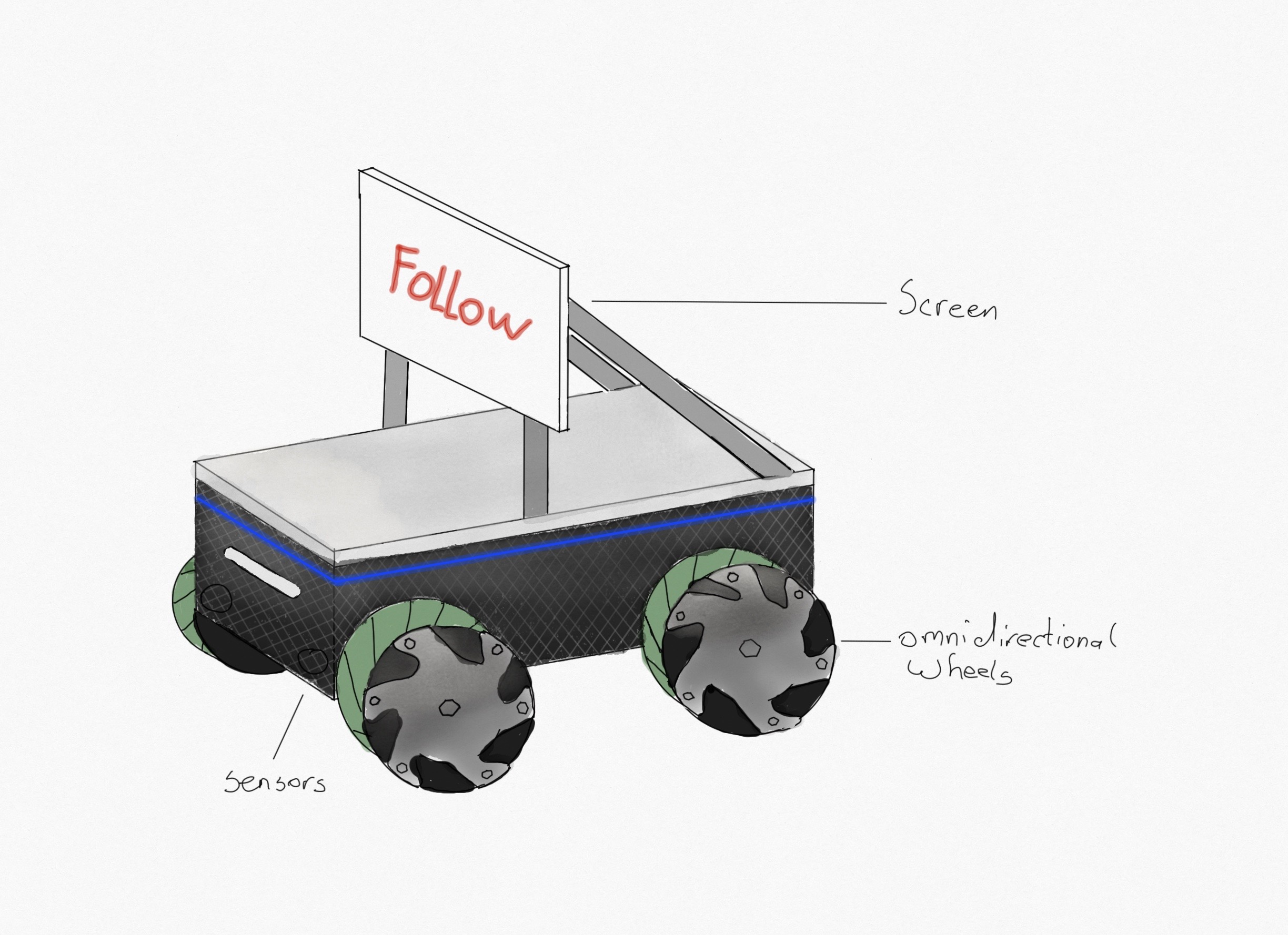
Detailing
Approximations
In order to find appropriate components for the robot, estimations have to be made. Therefore, in this section some global parameters are established.
In the figure at solution 4, the current concept is depicted. This figure gives a course overview of all the components that need to be present in the final design. The final design needs to have the following components; a screen or light display for interaction with the secondary user, wheels, suspension, actuators, sensors, a computer, a battery pack and additional lighting.
With regard to mass, the led screen of the robot has an approximate mass of 20 kg. [41] Next to that, the four omnidirectional Mecanum wheels of 254 mm diameter have a combined mass of 12 kg [42]. Concerning the sensors, these consist of Lidars, camera's and radar. The weight of these sensors combined is expected to be 1 kg. [43][44] In order to compute the algorithm, hardware is needed. This hardware is guessed to be 10 kg.
All components have to be put together in a structure. This structure needs to be rigid and needs to resist minor crash loads. The structure combined with the spring dampers is expected to weigh 20 kg.
The wheels have to be individually propelled with actuators. These actuators need to accelerate and decelerate (using dc injection braking). The robot will travel at an average velocity of 15 km/h in the parking lot. If the robot has a maximum speed of 30 km/h and accelerates at a maximum acceleration of 2 m/s^2, for a robot weighing 100 kg, a force of 200 N is needed. Given a wheel diameter of 254 mm, the required torque is equal to 25 Nm and the total power 1700 W. To prevent needing a gearbox, the maximum rpm of the actuator should be equal to:
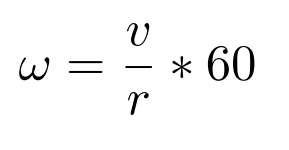
Hence, [math]\displaystyle{ \omega }[/math] is equal to 4000 rpm. The required power can be distributed over four actuators. Therefore, each actuator needs a power of 425 W, a torque of 6.25 Nm and a maximum of 4000 rpm. The Transmotec D123182-12 fits the power requirements running at a slightly lower rpm. [45] This actuator weighs approximately 7.5 kg. In total the actuators have a weight of 30 kg.
Finally, the actuators, screen and computer components have to be supplied with power. The actuators need to provide a mechanical power of 1700 W. The efficiency of an electric motor is dependent of the work load of the motor. [46] If the efficiency is assumed 70%, the required electric power is equal to 2500 W. On top of that, the screen has an electric power of 130 W. Finally, the processing power of the computer is approximated at 1000 W. The sensors also require power combined with the additional lighting, this amounts to a total electric power of 4 kW. Assuming that the batteries can charge at the end of the day, the robot needs to be functional for eight hours. Therefore, the batteries need to store 32 kWh, if losses are neglected. The capacity of a lithium-ion battery is 265 Wh/kg [47]. This means the battery pack would weigh 120 kg. This is not feasible, therefore, it is assumed that the robot can charge during the day. If the robot has an operating duration of two hours, the battery needs a capacity of 8000 kWh. This would result in a mass of 30 kg.
In total, the robot would weigh approximately 120 kg. Next to mass, volume is an important factor. The battery has an energy density of 693 Wh/L. Therefore, the battery pack has a volume of 12 L. The actuators have a combined volume of 9 L.
Appearance
If the previous approximations are taken into account, the parking assistant robot could take the following appearance:
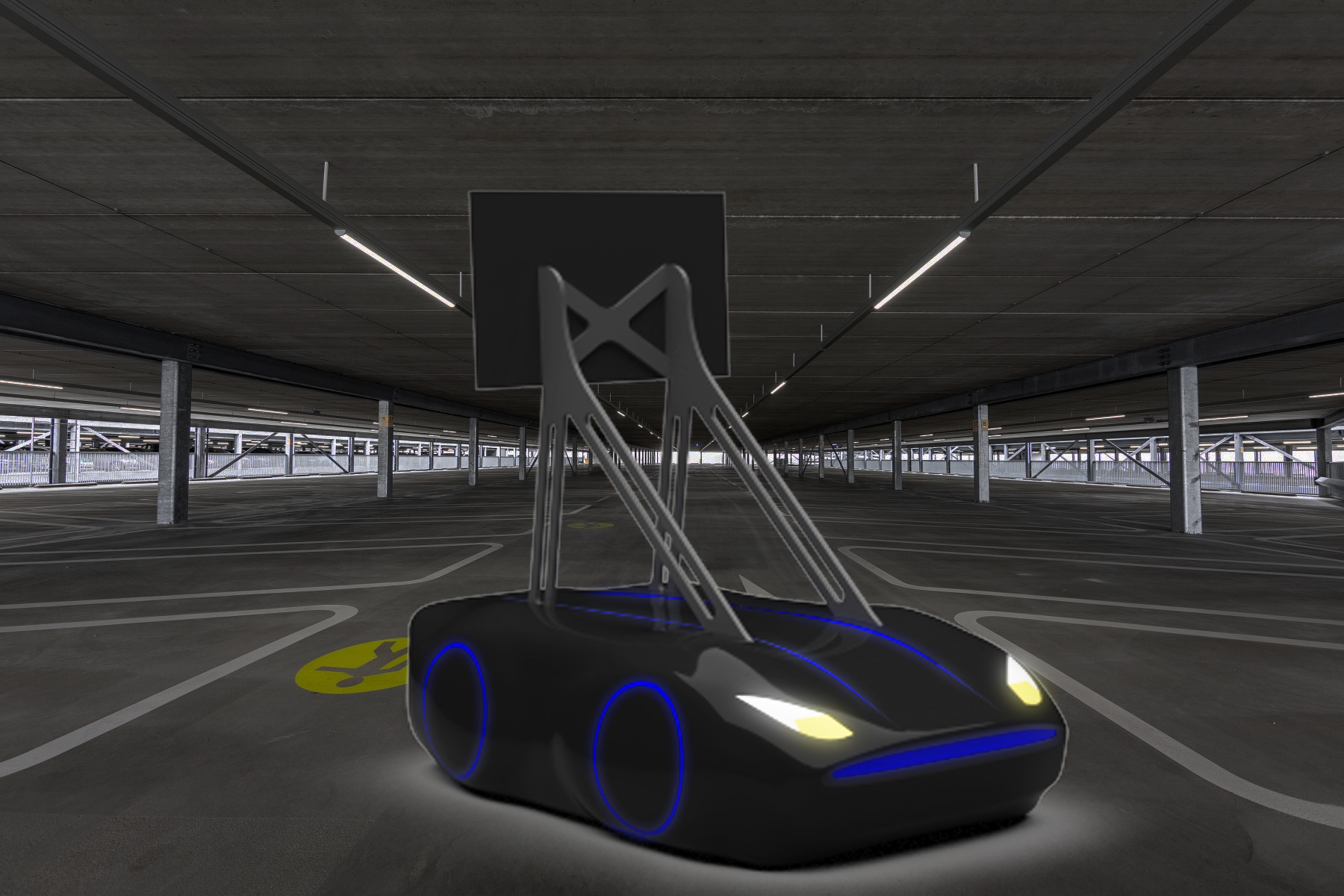
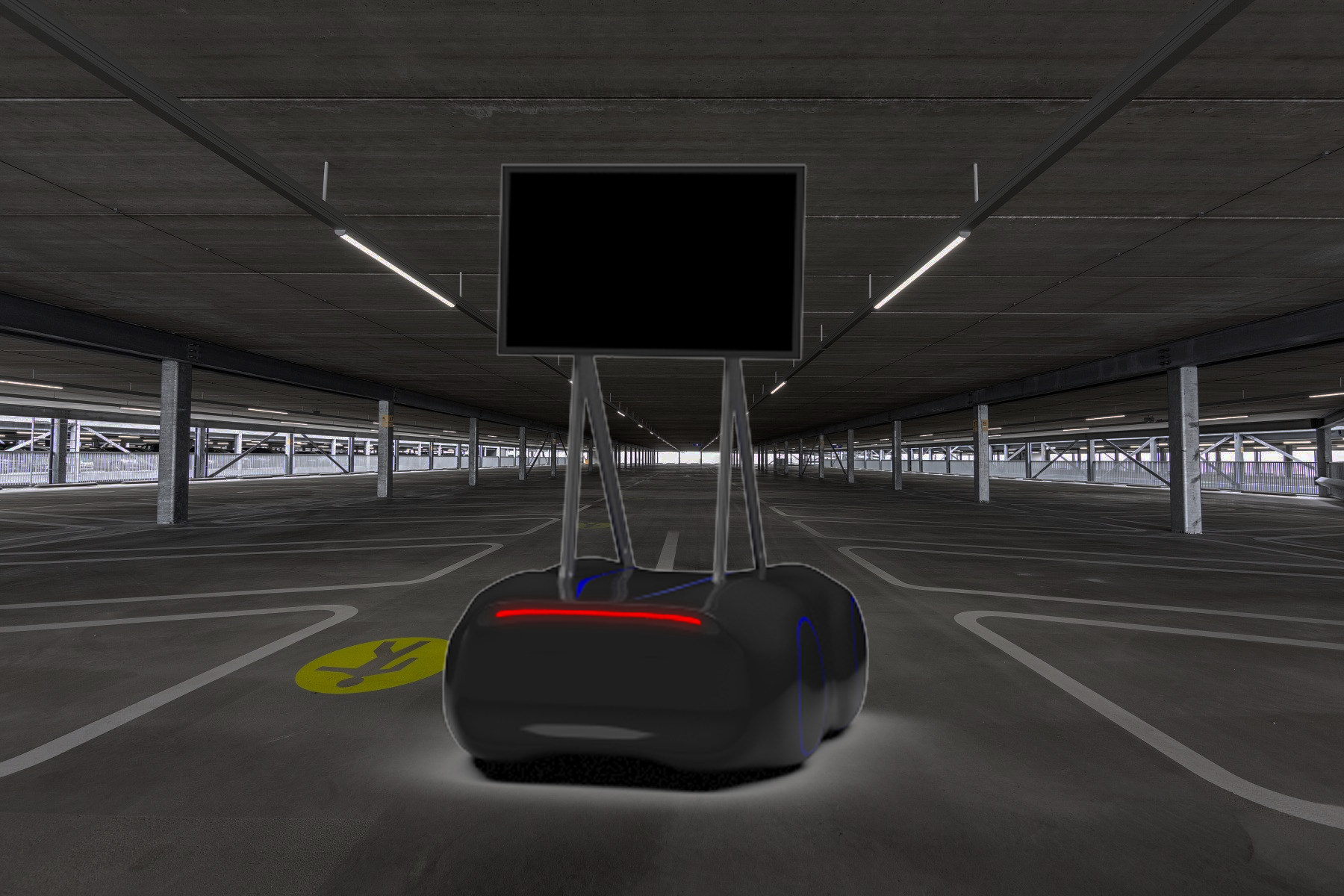
Conclusion
Discussion
Planning
| Activities | Person(s) | |
|---|---|---|
| Week 1 |
|
|
| Week 2 |
|
|
| Week 3 |
|
|
| Week 4 |
|
|
| Week 5 |
|
|
| Week 6 |
|
|
| Week 7 |
|
|
| Week 8 |
|
|
Log
Week 1
| Name | Hours | Summary |
|---|---|---|
| Luc | 15 | Introduction lecture, two meetings, brainstorm on possible subjects, literature study, written: State-of-art |
| Mandy | 15 | Introduction lecture, two meetings, brainstorm on possible subjects, literature study, written: User, Society, and Enterprise |
| Rien | 15 | Introduction lecture, two meetings, brainstorm on possible subjects, literature study |
| Sietse | 17 | Introduction lecture, two meetings, brainstorm on possible subjects, literature study, problem statement, RPCs |
| Tar | 10 | Introduction lecture, two meetings, brainstorm on possible subjects, literature study |
Week 2
| Name | Hours | Summary |
|---|---|---|
| Luc | 10 | Two meetings, RPC's |
| Mandy | 10 | Meeting with tutor, meeting with group afterwards, improved: user, society, enterprise, researched valet parking costs |
| Rien | 10 | Two meetings, RPC's |
| Sietse | 9 | Concepting: researching and drawing partial solutions, and drawing entire solutions. |
| Tar | 6 | Two meetings, Concept descriptions |
Week 3
| Name | Hours | Summary |
|---|---|---|
| Luc | 5 | Meeting Tutor + Meeting Group afterwards, Meeting RPC's with Mandy: improved RPC's |
| Mandy | 5 | Meeting Tutor + Meeting Group afterwards, Meeting RPC's with Luc: improved RPC's |
| Rien | X | Summary |
| Sietse | 5 | Meeting Tutor + Meeting Group afterwards, devising and drawing a new four wheel omnidirectional concept |
| Tar | 18 | Meeting Tutor + Meeting Group afterwards, wrote something about objectives and other small sections, started parking tracking software |
Week 4
| Name | Hours | Summary |
|---|---|---|
| Luc | X | Summary |
| Mandy | X | Summary |
| Rien | X | Summary |
| Sietse | 20 | Meeting Tutor + 2 x Meeting group, researching and approximating important robot parameters (required motors, wheel, battery pack, etc.), creating 3D geometry of body, Rendering geometry. |
| Tar | X | Summary |
Week 5
| Name | Hours | Summary |
|---|---|---|
| Luc | X | Summary |
| Mandy | X | Summary |
| Rien | X | Summary |
| Sietse | X | Summary |
| Tar | X | Summary |
Week 6
| Name | Hours | Summary |
|---|---|---|
| Luc | X | Summary |
| Mandy | X | Summary |
| Rien | X | Summary |
| Sietse | X | Summary |
| Tar | X | Summary |
Week 7
| Name | Hours | Summary |
|---|---|---|
| Luc | X | Summary |
| Mandy | X | Summary |
| Rien | X | Summary |
| Sietse | X | Summary |
| Tar | X | Summary |
Week 8
| Name | Hours | Summary |
|---|---|---|
| Luc | X | Summary |
| Mandy | X | Summary |
| Rien | X | Summary |
| Sietse | X | Summary |
| Tar | X | Summary |
References
- ↑ Ruan, J. M., Liu, B., Wei, H., Qu, Y., Zhu, N., & Zhou, X. (2016). How Many and Where to LocateParking Lots? A Space–time Accessibility-Maximization Modeling Framework for Special EventTraffic Management. Urban Rail Transit,2(2), 59–70. doi: 10.1007/s40864-016-0038-9
- ↑ Currie, G., & Shalaby, A. (2012). Synthesis of Transport Planning Approaches for the World’s LargestEvents. Transport Reviews,32(1), 113–136. doi: 10.1080/01441647.2011.601352
- ↑ Maheshwari, K. A., & Bagavathi Sivakumar, P. (2018). Use of predictive analytics towards better management of parking lot using image processing. Lecture Notes in Computational Vision and Biomechanics,28, 774–787. doi: 10.1007/978-3-319-71767-8{\}67
- ↑ Han, Y., Shan, J., Wang, M., & Yang, G. (2017). Optimization design and evaluation of parking routebased on automatic assignment mechanism of parking lot. Advances in Mechanical Engineering,9(7), 1–9. doi: 10.1177/1687814017712416
- ↑ https://www.ncbi.nlm.nih.gov/pmc/articles/PMC4236010/
- ↑ https://dl.acm.org/doi/pdf/10.1145/2157689.2157769
- ↑ https://www.anwb.nl/juridisch-advies/in-het-verkeer/verkeersregels/afmetingen-van-autos-en-aanhangers
- ↑ https://www.nu.nl/algemeen/647351/autos-te-groot-voor-parkeervak.html?redirect=1
- ↑ https://ocw.tudelft.nl/course-readings/parkeren/
- ↑ Winter Nie, Waiting: integrating social and psychological perspectives in operations management, Omega, Volume 28, Issue 6, 2000, Pages 611-629, ISSN 0305-0483
- ↑ Chin, Hoong & Rahman, Md. Habibur. (2011). An Impact Evaluation of Traffic Congestion on Ecology. Planning Studies & Practice. 3. 32-44.
- ↑ Charles P.Gerba. Adam L.Wuollet, Peter Raisanen, Gerardo U.Lopez (2016). Bacterial contamination of computer touch screens, American Journal of Infection Control, Volume 44, Issue 3, Pages 358-360, doi: 10.1016/j.ajic.2015.10.013
- ↑ Dirk Van Compernolle, Weiye Ma, Fei Xie, Marc Van Diest (1990), Speech recognition in noisy environments with the aid of microphone arrays, Speech Communication Volume 9, Issues 5–6, Pages 433-442, doi: 10.1016/0167-6393(90)90019-6
- ↑ https://ai.googleblog.com/2018/04/looking-to-listen-audio-visual-speech.html
- ↑ Stefan Waldherr, Roseli Romero, Sebastian Thrun (1990). A Gesture Based Interface for Human-Robot Interaction, Autonomous Robots volume 9, Pages 151–173, doi: 10.1023/A:1008918401478.
- ↑ Katalin Szendrei, Pirmin Ganter, Olalla Sànchez‐Sobrado, Roland Eger, Alexander Kuhn, Bettina V. Lotsch (2015). Touchless Optical Finger Motion Tracking Based on 2D Nanosheets with Giant Moisture Responsiveness, Advanced Materials, Volume 27, Issue 41, Pages 6341-6348, doi: 10.1002/adma.201503463
- ↑ Teodoroviç D. & Luciç P. (2006). Intelligent parking systems, European Journal of Operational Research, Volume 175, Issue 3, Pages 1666-1681
- ↑ Muraki (2003). United States Patent: Parking lot guidance system and parking lot guidance program , Patent No.: US 6,650,250 B2
- ↑ Li (2005). United States Patent: Management method and system for a parking lot , Patent No.: US 6,917,307 B2
- ↑ Winter et al. (2006) United States Patent: Apparatus and method for sensing the occupancy status of parking spaces in a parking lot, Patent No.: US 7,116,246 B2
- ↑ Panayappan, Ramu and Trivedi, Jayini Mukul and Studer, Ahren and Perrig, Adrian (2007). VANET-Based Approach for Parking Space Availability, Proceedings of the Fourth ACM International Workshop on Vehicular Ad Hoc Networks, Pages 75-76, doi: 10.1145/1287748.1287763
- ↑ Felix Caicedo, Carola Blazquez, Pablo Miranda (2012). Prediction of parking space availability in real time,Expert Systems with Applications, Volume 39, Issue 8, Pages 7281-7290, doi: 10.1016/j.eswa.2012.01.091
- ↑ Yanxu Zheng, S. Rajasegarar and C. Leckie (2015). Parking availability prediction for sensor-enabled car parks in smart cities IEEE Tenth International Conference on Intelligent Sensors, Sensor Networks and Information Processing (ISSNIP), Pages 1-6.
- ↑ 24.0 24.1 https://www.typescriptlang.org/
- ↑ https://nodejs.org/en/
- ↑ https://socket.io/
- ↑ https://reactjs.org/
- ↑ https://www.npmjs.com/package/model-react
- ↑ https://www.pixijs.com/
- ↑ https://github.com/michalochman/react-pixi-fiber
- ↑ https://developer.microsoft.com/en-us/fluentui
- ↑ 32.0 32.1 https://en.wikipedia.org/wiki/Dijkstra%27s_algorithm
- ↑ https://en.wikipedia.org/wiki/Min-max_heap
- ↑ C. Richard Cassady, John E. Kobza (1998). A Probabilistic Approach to Evaluate Strategies for Selecting a Parking Space, Transportation Science, Volume 32, Issue 1, Pages 3-85
- ↑ Schuessler (1998). Method and device for guiding vehicles as a function of the traffic situation , Patent No.: US 5,818,356
- ↑ P. M. d'Orey, J. Azevedo and M. Ferreira (2016) Exploring the solution space of self-automated parking lots: An empirical evaluation of vehicle control strategies, IEEE 19th International Conference on Intelligent Transportation Systems (ITSC), Pages 1134-1140.
- ↑ Li (2005). United States Patent: Management method and system for a parking lot , Patent No.: US 6,917,307 B2
- ↑ Cox, I. J., & Wilfong, G. T. (1990).Autonomous Robot Vehicles(Vol. 6). Springer, New York, NY. doi:https://doi-org.dianus.libr.tue.nl/10.1007/978-1-4613-8997-2
- ↑ Zhao, X., Sun, P., Xu, Z., Min, H., & Yu, H. (2020). Fusion of 3D LIDAR and Camera Data for ObjectDetection in Autonomous Vehicle Applications.IEEE Sensors Journal,20(9), 4901–4913. doi:10.1109/JSEN.2020.2966034
- ↑ Vozar, S. (n.d.).Sensors for Autonomous Vehicles.Retrieved fromhttps://ieeexplore-ieee-org.dianus.libr.tue.nl/courses/details/EDP538
- ↑ https://www.coolblue.nl/product/827634/samsung-qe55q70r-qled.html
- ↑ https://robotdiscounter.com/a-set-of-254mm-aluminium-mecanum-wheels-4-pieces-bearing-rollers-14131?utm_source=kelkoonl&utm_medium=cpc&utm_campaign=kelkooclick&utm_term=A+set+of+254mm+Aluminium+Mecanum+Wheels+
- ↑ https://www.kamera-express.nl/product/12224571/kodak-pixpro-orbit360-4k-action-cam-standard/?channable=e13909.MTIyMjQ1NzE&gclid=CjwKCAjwkun1BRAIEiwA2mJRWZEzqWN6lqiHoi8hXR6fY_an8EiIgA3UmhNDRge7aXZuR0PQDvwzfhoCQowQAvD_BwE
- ↑ https://nl.rs-online.com/web/p/photoelectric-sensors/1893497?cm_mmc=NL-PLA-DS3A-_-google-_-CSS_NL_NL_Automation_And_Control_Gear_New-_-Sensors_And_Transducers%7CPhotoelectric_Sensors-_-PRODUCT_GROUP&matchtype=&pla-308865050060&gclid=CjwKCAjwkun1BRAIEiwA2mJRWZUZTu59GieFll1VvDDsd2i1LC6pBzw6Rmu2mKRu4pDt8SaDB-ak4RoCLr8QAvD_BwE&gclsrc=aw.ds
- ↑ https://www.transmotec.com/product/d123182-12/?c=eur
- ↑ https://www.energy.gov/sites/prod/files/2014/04/f15/10097517.pdf
- ↑ https://en.wikipedia.org/wiki/Lithium-ion_battery